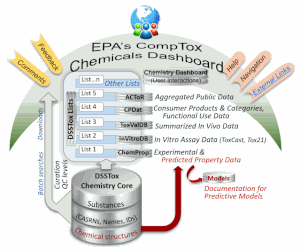
Back কম্পটক্স কেমিক্যাল ড্যাশবোর্ড Bengali/Bangla CompTox Chemicals Dashboard Catalan CompTox Chemicals Dashboard German CompTox Chemicals Dashboard Greek CompTox Chemicals Dashboard ID CompTox Chemicals Dashboard Malay CompTox Chemicals Dashboard Slovenian CompTox Kimyasal Bilgi Paneli Turkish
 | |
| Content | |
|---|---|
| Description | Chemicals database targeted towards the environmental sciences and providing access to over 875,000 chemical compounds, properties, bioassay data and associated information. |
| Contact | |
| Research center | Environmental Protection Agency |
| Laboratory |
|
| Primary citation | The CompTox Chemistry Dashboard: a community data resource for environmental chemistry.[1] |
| Access | |
| Website | comptox |
| Download URL | comptox |
| Miscellaneous | |
| License | Public Domain |
| Data release frequency | Every 6 months |
| Curation policy | Manually curated |
The CompTox Chemicals Dashboard is a freely accessible online database created and maintained by the U.S. Environmental Protection Agency (EPA). The database provides access to multiple types of data including physicochemical properties, environmental fate and transport, exposure, usage, in vivo toxicity, and in vitro bioassay. EPA and other scientists use the data and models contained within the dashboard to help identify chemicals that require further testing and reduce the use of animals in chemical testing. The Dashboard is also used to provide public access to information from EPA Action Plans, e.g. around perfluorinated alkylated substances.[2][3]
Originally titled the Chemistry Dashboard, the first version was released in 2016.[4] The latest release of the database (version 3.0.5) contains manually curated data for over 875,000 chemicals and incorporates the latest data generated from the EPA's Toxicity Forecaster (ToxCast) high-throughput screening program.[5] The Chemicals Dashboard incorporates data from several previous EPA databases into one package including the ToxCast Dashboard,[6] the Endocrine Disruption Screening Program (EDSP) Dashboard[7] and the Chemical and Products Database (CPDat).[8]
- ^ Williams, Antony J.; et al. (2017-11-18). "The CompTox Chemistry Dashboard: a community data resource for environmental chemistry". Journal of Cheminformatics. 9 (1): 61. doi:10.1186/s13321-017-0247-6. PMC 5705535. PMID 29185060.
- ^ Keyt, Bryan; Lee, Thomas; Poplawski, Steven (27 March 2019). "EPA Announces Per- and Polyfluoroalkyl Substances (PFAS) Action Plan: Overview and Next Steps". JD Supra. Retrieved 21 April 2019.
- ^ Patlewicz, G; et al. (Jan 2019). "A Chemical Category-Based Prioritization Approach for Selecting 75 Per- and Polyfluoroalkyl Substances (PFAS) for Tiered Toxicity and Toxicokinetic Testing". Environmental Health Perspectives. 127 (1): 014501. doi:10.1289/EHP4555. PMC 6378680. PMID 30632786.
- ^ Williams, Antony J.; Grulke, Christopher M.; Edwards, Jeff; McEachran, Andrew D.; Mansouri, Kamel; Baker, Nancy C.; Patlewicz, Grace; Shah, Imran; Wambaugh, John F. (2017-11-28). "The CompTox Chemistry Dashboard: a community data resource for environmental chemistry". Journal of Cheminformatics. 9 (1): 61. doi:10.1186/s13321-017-0247-6. ISSN 1758-2946. PMC 5705535. PMID 29185060.
- ^ US EPA, ORD (2015-08-21). "Toxicity Forecasting". US EPA. Retrieved 2019-04-22.
- ^ US EPA, ORD (2017-11-01). "Exploring ToxCast Data". US EPA. Retrieved 2019-04-22.
- ^ US EPA, OCSPP (2015-08-14). "Endocrine Disruptor Screening Program (EDSP) in the 21st Century". US EPA. Retrieved 2019-04-22.
- ^ US EPA, ORD (2016-08-04). "Chemical and Products Database (CPDat)". US EPA. Retrieved 2019-04-22.